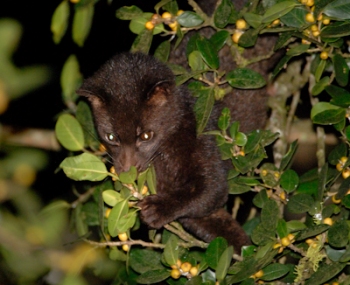When is a carnivore no longer a carnivore? A new study in mongabay.com’s open access journal Tropical Conservation Science has found that the brown palm civet (Paradoxurus jerdoni), a cat-sized tree-loving carnivore, lives almost entirely off fruit and seeds. Studying over a 1000 feces from the brown palm civet during three years, researchers found that 97 percent of its diet was composed of plants, not meat. Given its penchant for fruit, researchers argue that the brown palm civet is an important disperser of tropical plants, playing a vital ecological role rarely connected to civets.
In total researchers found that the brown palm civet consumed 53 native plant species, 4 introduced plants, and 8 plants which could not be identified.
“Brown palm civets carry seeds away from under the parent trees and defecate them virtually undamaged, with seed germination viability being retained or even enhanced in some species,” write the study’s authors, arguing that this species of civets plays a large role in effectively dispersing seeds.
 The brown palm civet. |
When not feeding on plants, the civets turned largely to invertebrates, eating vertebrates—mammals, birds, or reptiles—only 4 percent of the time. While other civets have been known to eat fruits, this study confirms that India’s brown palm civet is “one of the most frugivorous” carnivores in the world, according to the writers. Only the kinkajou of the Neotropics surpasses it.
The researchers argue that the brown palm civet could play a big role in forest restoration efforts given “their ability to persist in fragmented rainforest landscapes, including small and/or degraded fragments”. The fact that many other seed dispersers are absent from forest fragments makes the brown palm civet even more important.
Endemic to the Western Ghats of India, the brown palm civet is listed as Least Concern by the IUCN Red List. However continued forest conversion to agriculture has raised some concerns, since the species appears to require access to rainforest in order to survive.
CITATION: Mudappa, D., Kumar, A., and Chellam, R. 2010. Diet and fruit choice of the brown palm civet Paradoxurus jerdoni, a viverrid endemic to the Western Ghats rainforest, India. Tropical Conservation Science Vol. 3 (3):282-300.
Related articles
Long-distance seed dispersal and hunting, an interview with Kimberly Holbrook

(05/24/2010) Scientists are just beginning to uncover the complex relationship between healthy biodiverse tropical forests and seed dispersers—species that spread seeds from a parent tree to other parts of the forest including birds, rodents, primates, and even elephants. By its very nature this relationship consists of an incredibly high number of variables: how abundant are seed dispersers, which animals spread seeds the furthest, what species spread which seeds, how are human impacts like hunting and deforestation impacting successful dispersal, as well as many others. Dr. Kimberly Holbrook has begun to answer some of these questions.
How hornbills keep Asian rainforests healthy and diverse, an interview with Shumpei Kitamura
(04/26/2010) Hornbills are one of Asia’s most attractive birds. Large, colorful, and easier to spot than most other birds, hornbills have become iconic animals in the tropical forests of Asia. Yet, most people probably don’t realize just how important hornbills are to the tropical forests they inhabit: as fruit-eaters, hornbills play a key role in dispersing the seeds of tropical trees, thereby keeping forests healthy and diverse. Yet, according to tropical ecologist and hornbill-expert Shumpei Kitamura, these beautiful forest engineers are threatened by everything from forest loss to hunting to the pet trade.
Seed dispersal in the face of climate change, an interview with Arndt Hampe

(04/05/2010) Without seed dispersal plants could not survive. Seed dispersal, i.e. birds spreading seeds or wind carrying seeds, means the mechanism by which a seed is moved from its parent tree to a new area; if fortunate the seed will sprout in its new resting place, produce a plant which will eventually seed, and the process will begin anew. But in the face of vast human changes—including deforestation, urbanization, agriculture, and pasture lands, as well as the rising specter of climate change, researchers wonder how plants will survive, let alone thrive, in the future?
